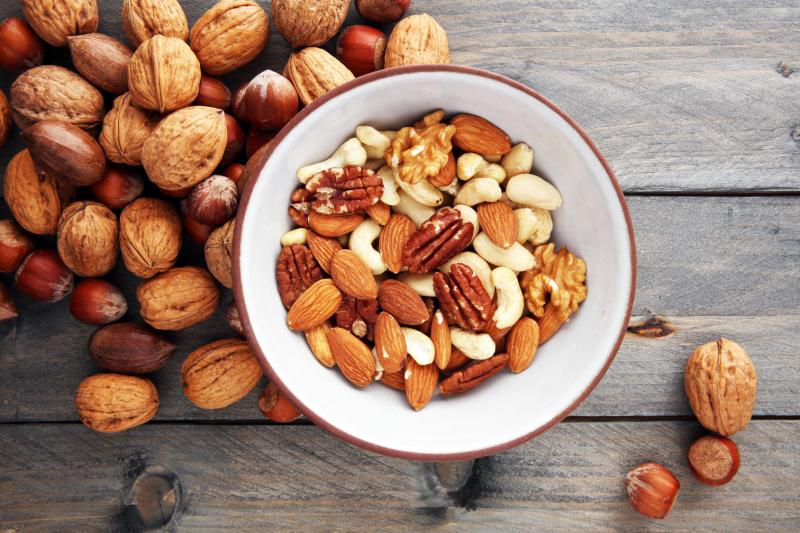Eating more nuts may lower risk of death





Greater intake of tree and ground nuts appears to reduce the risk of mortality from both cardiovascular and noncardiovascular causes in low-, middle-, and high-income countries, suggests a recent study.
“[N]ut consumption was associated with a lower risk of mortality in a diverse multinational cohort after adjusting for other lifestyle and dietary factors,” the researchers said. “These findings support recommendations to increase the intake of a variety of nuts, as part of a healthy dietary pattern, to reduce the risk of death.”
This large multinational prospective cohort study included adults aged 35–70 years from 16 low-, middle-, and high-income countries on five continents. Country-specific validated food frequency questionnaires were used to measure nut intake at baseline visit.
A total of 124,329 participants (mean age, 50.7 years; 41.5 percent male) were followed for a median of 9.5 years. Overall, 10,928 composite events were recorded, of which 8,662 were deaths and 5,979 were major cardiovascular events. [Am J Clin Nutr 2020;112:208-219]
Higher consumption of nuts (>120 g per week vs <30 g per mo) resulted in a reduced risk of the primary composite outcome of mortality or major cardiovascular event (multivariate hazard ratio [mvHR], 0.88, 95 percent confidence interval [CI], 0.80–0.96; ptrend=0.0048).
Significant decreases were also seen in total (mvHR, 0.77, 95 percent CI, 0.69–0.87; ptrend<0.0001), cardiovascular (mvHR, 0.72, 95 percent CI, 0.56–0.92; ptrend=0.048), and noncardiovascular mortality (mvHR, 0.82, 95 percent CI, 0.70–0.96; ptrend=0.0046), as well as a trend towards reduced cancer mortality (mvHR, 0.81, 95 percent CI, 0.65–1.00; ptrend=0.081).
Furthermore, nut consumption was not associated with major cardiovascular disease (CVD; mvHR, 0.91, 95 percent CI, 0.81–1.02; ptrend=0.14), stroke (mvHR, 0.98, 95 percent CI, 0.84–1.14; ptrend=0.76), or myocardial infarction (mvHR, 0.86, 95 percent CI, 0.72–1.04; ptrend=0.29).
“Our results agree with previous observational studies of nuts and mortality, mainly in North America and Europe, which report lower relative risks (RRs) with higher nut consumption ranging from 11 to 50 percent,” the researchers said. [Heart 1997;78:450-455; N Engl J Med 2013;369:2001-2011; Arch Intern Med 1997;157:2249-2258; Int J Epidemiol 2015;44:1038-1049]
A meta-analysis of the observational studies revealed a pooled RR of 0.81 (95 percent CI, 0.77–0.85), while another dose-response meta-analysis of studies from middle- and high-income countries reported pooled RRs of 0.71 for coronary artery disease, 0.93 for stroke, 0.79 for CVD, 0.85 for cancer, and 0.78 for mortality (per 28 g/d).
Nuts contain several nutrients that may contribute to the association with reduced mortality. While nearly 80 percent of its energy comes from fat, most nuts are low in saturated fat (4–16 percent) and have no trans fat. [Curr Atheroscler Rep 2008;10:529-535]
Both mono- and polyunsaturated fat may confer benefits on inflammation, low-density lipoprotein (LDL) cholesterol, and the LDL: high-density lipoprotein cholesterol ratio, triglycerides, and blood pressure. Both fats are also inversely associated with CVD outcomes. [J Physiol Biochem 2013;69:633-651; Am J Epidemiol 2005;161:672-679; Lancet Diabetes Endocrinol 2017;5:774-778]
“In addition, nut consumption may displace the intake of less healthy foods such as highly refined sugars and starches, reducing the glycaemic load, which has been linked with increased CVD, a major contributor to mortality,” the researchers said. [PLoS One 2014;9:e103376; Atherosclerosis 2012;223:491-496]